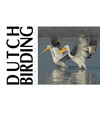Dutch Birding volume 29 (2007) no 3

Unidentified nuthatch in Siberian Altay in July 2006
In the summer of 2006, Esther van den Heuvel, Bas Roels, John Smit and Theo Zeegers participated in an entomological expedition to the Altay mountains in southern Siberia, more or less on the crossing of China, Kazakhstan, Mongolia and Russia. At one of our campsites, at an altitude of c 2000 m up in the Aktru valley in the central Chuiskiy range, we saw a small nuthatch Sitta which resembled, in our frame of reference, Corsican Nuthatch S whiteheadi. Of course, we knew that this was impossible but with nothing more than a European field guide (Heinzel et al 1996) at hand, we were not able to identify it properly.
The place where we observed the nuthatch was: Aktru, south of Karay, at 2000 m above sea level (50°05'12.2'' N, 87°46'59.4'' E), Kosh-Arachskiy Rajon, Respublika Altay, southern Siberia, Russia. This site is a valley at the end of two glaciers, and more or less at the timberline, c 100 km from the Mongolian border. The forest was a pure stand of larch Larix.
Because it turned out that a pair of this nuthatch was breeding in a larch, we saw the species repeatedly. The two were sexually dimorphic: the male had a black cap, whereas the female had no black cap; both had a distinct dark eye-stripe and a white supercilium. These are exactly the features of Chinese Nuthatch S villosa (cf Harrap & Quinn 1996). The underparts, however, showed relatively little buff coloration, as compared with typical villosa.
The only nuthatch species with a distribution that is known to include southern Siberia is Eurasian Nuthatch S europaea (Harrap & Quinn 1996). However, the clear black cap in the male as well as the white supercilium in both sexes and the small size exclude Eurasian.
According to Nazarenko (2006), the distributional area of Chinese Nuthatch is situated somewhere between 33-45° N and 100-133° E. Its breeding range is quite patchy. If the nuthatch we observed was indeed Chinese, then this would be a breeding record far outside its known breeding range. Another possibility is that our nuthatch could represent a new, undescribed Sitta species. At this moment, based on our field observation, this remains an open question. Either way, the discovery of a breeding pair of Sitta (cf) villosa in the Russian part of the Altay mountains remains a surprising discovery and requires further investigations.
Interestingly, nuthatches have something of a reputation when it comes to remaining undiscovered for a long time; the two most recently described new species for the Western Palearctic were both nuthatches: Corsican Nuthatch (described in 1883) and Algerian Nuthatch S ledanti (described in 1976).
John T Smit, Wolvenstraat 62, 3512 CH Utrecht, Netherlands
(jtsmit planet.nl)
planet.nl)
Theo Zeegers, Eikenlaan 24, 3768 EV Soest, Netherlands
(th.zeegers xs4all.nl)
xs4all.nl)
Esther van den Heuvel, Eikenlaan 24, 3768 EV Soest, Netherlands
(e.vdheuvel xs4all.nl)
xs4all.nl)
Bas Roels, Rembrandtkade 57-1, 3583 TR Utrecht, Netherlands
(broels xs4all.nl)
xs4all.nl)
terug






